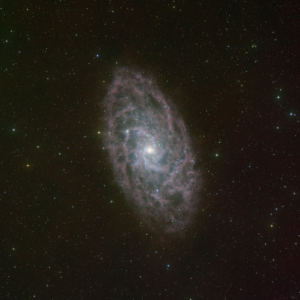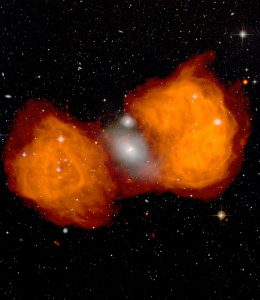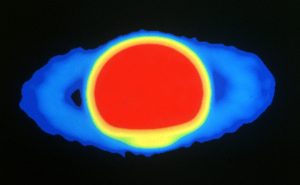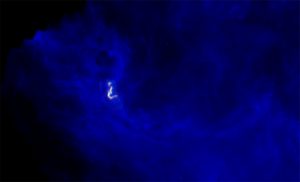In this combined optical and radio image, the faint galaxy in the constellation Triangulum looks like lace hanging in the sky. Also known as M33, the Triangulum Galaxy is part of the Local Group of galaxies, which includes the Andromeda Galaxy and our galaxy, the Milky Way. M33 is over thirty thousand light years across, and more than two million light years away. The optical data in this image (white) show the many stars within the galaxy as well as reddish star forming regions that are filled with hot Hydrogen gas. The radio data (colored pink) from the Very Large Array (VLA) reveal the cool Hydrogen gas within the galaxy, gas which cannot be seen with an optical telescope. Combined together, the radio and optical give a more comprehensive view of star formation in this galaxy.


Galactic Center
The center of our Milky Way Galaxy is only clearly visible to radio telescopes. The supermassive black hole in its core is glaring in radio waves, surrounded by the smokerings of supernova remnants and the arcs of material caught in the core’s strong magnetic fields. This gigantic image was pieced together by multiple observations taken by the Very Large Array (VLA).

Famous Fornax Galaxy
Fornax A is a galaxy with a very active black hole in its core that is spraying radio waves out into enormous jets. Here, the white glow in the center is the visible galaxy NGC 1316 that you can see through the constellation of Fornax. Notice the wee spiral galaxy above it? These two galaxies are merging, and as gas and dust are stripped out of the small galaxy and poured into the center of NGC 1316, the black hole nestled there spins it up. How do we know this? The huge radio lobes to either side of this merger are the telltale signs that a black hole is being fed more than it can handle. These are the billowing ends of powerful jets shooting out spun-up, escaped material far into space.

Fornax in Blue
Radio waves are invisible to our eyes, therefore, they do not arrive in any “color” that we’ve ever known. When we take our data and plot it, our artists can assign any color they please to the results. In this image of the famous Fornax radio galaxy, our artist tried a blue coloring for the enormous lobes of gas this galaxy’s black hole sprays out.

Saturn in Radio Waves
2cm/15GHz image taken by the VLA in the C-array, resolution 1.5 arcsec image of Saturn. Rings are wide open. The A and B rings are clearly visible.

Stars Forming Together in Barnard 5
The B5 complex (red and green; radio images taken with the VLA and GBT) seen within its neighborhood, embedded in dust (blue) as seen with ESA’s Herschel Space Observatory, in infrared light.





